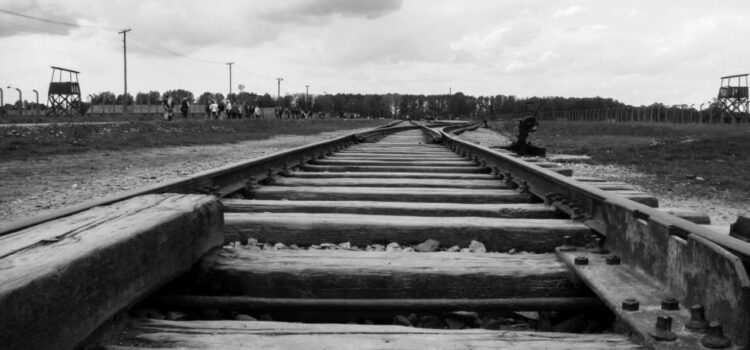

This article is an excerpt from the Shortform book guide to "The Tattooist of Auschwitz" by Heather Morris. Shortform has the world's best summaries and analyses of books you should be reading.
Like this article? Sign up for a free trial here .
Why were Lale and Gita separated in The Tattooist of Auschwitz? What happened at the end of Auschwitz?
In 1945, the Russians started to close in to bring the end of Auschwitz concentration camp. The women, including Gita, were rounded up and sent away. Meanwhile, Lale is sent to another camp. They didn’t know if they would ever see each other again.
Continue reading to learn what happened to Lale and Gita at the end of Auschwitz.
The End of Auschwitz
Months go by with no sign of the Russians. A cold fall turns into a colder winter. The year changes to 1945, and the prisoners struggle as another dire year of life at the camp looms before them. The never-ending stream of new arrivals ceases, and Lale and the crematorium workers find themselves without work. It’s starting to feel like the end of Auschwitz.
Victor and Yuri, as well as their crew, no longer come to the camp. Nothing new is built. In fact, the Germans have started shipping prisoners out of Auschwitz-Birkenau. No one is sure where they’re headed. Gita and Cilka are in charge of processing the paperwork, but it doesn’t state the destination.
Not long after, Baretski tells Lale that Leon is no longer at the camp. Lale demands to know what happened to him, but Baretski warns that if Lale keeps up the questions, he could find himself in the same boat. Leon’s disappearance does something to Lale. He feels a new fighting spirit enter him, and he tells Baretski that he looks forward to watching Baretski’s world crumble around him. Baretski grips his holster and tells Lale to get inside where it’s warm. The cold is clouding his judgment.
A few weeks later, Gita dashes to Lale’s block in the snow. She tells him that the SS are running around in a panic at the administration building destroying documents. Lale tells Gita to find her friends and stay in the block, then he runs to the building to investigate. He runs into a female SS worker and finds out that the Germans are going to empty the camp starting tomorrow. The Russians are getting closer and so is the end of Auschwitz.
Lale rushes to Gita’s block with this news. He walks right in, her kapo nowhere to be found. He finds the women huddled with fear. He tells them the news and says they should stay in their block until further notice. Before he leaves, he delivers personal messages to each of Gita’s friends. He thanks Dana for helping to keep Gita alive all the times when she was ready to give up. He thanks Cilka for her help and tells her she is the strongest person he knows. When he turns to Gita, she refuses to let him speak. He will not say goodbye to her, she says. She’ll see him tomorrow, period.
As Lale leaves the block, he looks at the group of women. All young, all taken when they were barely women. Their futures, once full of promise and hope, have been taken. Even if they are set free, they will never be able to lead a normal life. He wishes them well and leaves.
The Road Out
The commotion at the camp dies down, and Lale is able to fall asleep. But he wakes up in the middle of the night to gunshots and loud voices. He walks outside and sees thousands of women lined up in rows awaiting a fate no one seems to have any information about, not even the SS. It’s pandemonium. Lale rushes through the rows searching for Gita. At last, he sees her near the main gate. Only Dana is with her, and they’re both crying.
Dana sees Lale first, and the two women move back in the line to try to get closer. Lale and Gita lock eyes across the yard. He wants to run to her, but an officer smacks him with a rifle across the face. Blood spurts from a large cut on his forehead, but he manages to stand. He pushes forward and screams Gita’s name. Somehow, amid the shouting and barking, he hears her call to him. She shouts her name, revealing her last name for the first time—Gita Furman. Lale watches his love get swept out with the rest of the women and stands helpless as the gate closes behind them.
The next morning, the chaos from the night before has bled into another day. The gate is open, and prisoners seem to stumble through, unsure of what to do. The guards are too crazed with panic to notice or care. Lale moves through the gate and sees a train idling down the road. A sea of men are pushed toward it, and Lale can’t get out of the way fast enough. He is shoved into a car, and the door closes. He peers through a crack and sees the remaining prisoners dropping to the ground as bullets fly from SS guns. The train begins to move, and through the falling snow, Lale watches Auschwitz-Birkenau get smaller and smaller until they’re gone. That was the end of Auschwitz.
Farther down the road, Gita, Dana, and the other women march through a thick layer of snow. The two search through the crowd for Ivana and Cilka, but they don’t see them. They march for hours, and many of the women succumb to exhaustion or the cold. When they fall, they’re shot. The group shrinks in size as another full day of marching comes and goes. Finally, Dana can go on no longer. She falls, and Gita tries desperately to pull her up, but it’s no use. Dana urges Gita to go on without her, but Gita doesn’t move until four girls pull her away. She waits for the shot to sound behind her, but she doesn’t hear it. A small moment of mercy.
Finally, the women make it to a train station, where several cattle wagons wait to be loaded. Across the field is an old farmhouse, and the girls, who Gita has learned are not Jewish but Polish, decide to make a run for it, and Gita joins them. The guards are so busy herding the women onto the train that they don’t notice Gita and the girls running off across the field. The door to the farmhouse opens as they approach, and suddenly they are on the floor in front of a fire. The owners give them bread and warm beverages and listen to their harrowing tale. The husband says they can’t stay with them because their house is often searched, but he gives them the address of a relative in a nearby town. That night, the girls sleep in a pile on the frozen forest floor, hoping they make it through the night.
Lovers Gita and Lale were separated at the end of Auschwitz and neither knew if they would ever see the other again.

———End of Preview———
Like what you just read? Read the rest of the world's best book summary and analysis of Heather Morris's "The Tattooist of Auschwitz" at Shortform .
Here's what you'll find in our full The Tattooist of Auschwitz summary :
- How a man used tattooing skills to stay alive at Auschwitz-Birkenau
- How Lale Sokolov fell in love in these unusual circumstances
- How Lale goes from concentration camp to Russian prisoner before finding freedom






